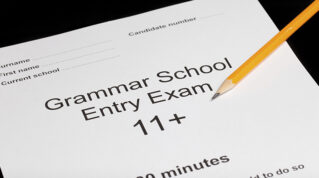The government appears to have watered down its agreement with grammar schools to admit more disadvantaged pupils.
A new memorandum of understanding (MoU) between the Department for Education and Grammar School Heads’ Association (GSHA) was published this week, covering the period from this year up to 2027.
Although the new document refers to a “shared ambition” to see more pupils from lower-income backgrounds admitted to selective schools, success measures in the last agreement have been slimmed down.
Schools Week revealed last year that the disadvantage gap between grammar schools handed £64 million to become more inclusive and their non-selective neighbours had widened.
In the previous agreement, the DfE and GSHA agreed to report on progress against a number of measures. This included “upwards trends” in the number of disadvantaged children applying to and admitted to selective schools.
The document now commits only to “evaluate progress”, including by “monitoring the numbers of disadvantaged children being admitted to selective schools with a view to seeing an upward trend”.
The goal of higher numbers of disadvantaged applicants has also been removed, with an ambition that all schools should prioritise disadvantaged pupils in admissions by the end of this parliament.
‘Pretty toothless affair’
Dr Nuala Burgess, the chair of Comprehensive Future, said the new MoU was “a pretty toothless affair”.
“There is nothing in the memorandum, but an implication that they intend to keep an eye on things with fingers crossed.”
Grammar schools should “come clean”, she said, and “clearly state the percentage increase of disadvantaged children they aim to admit, with a timeline, and how they intend to go about achieving their target”.

It follows a shortlived ambition by the government of Liz Truss last year to lift the ban on new grammar schools, something that was promptly dropped when Rishi Sunak took over.
Dr Mark Fenton, the chief executive of the GSHA , said the “level of ambition” in the agreement “remains unchanged”.
However, he admitted a “lack of available data around applicants to grammar schools meant that one of the previous success measures proved difficult to assess reliably”.
“By far the most important indicator of success remains the overall number of poorer children who benefit from the excellent education that grammar schools can offer. This has continued to rise, even though the achievement of disadvantaged children in primary school has fallen even further behind their peers as a result of the pandemic.”
A DfE spokesperson said the number of grammar schools offering priority admission to poorer pupils had risen from 63 in 2017, to 136 last year.
















What an utterly misleading headline. Why should DfE care about the numbers of disadvantaged children applying to a grammar school if they then don’t get in?
The most important measure, which is there, is an ambition to increase the number of disadvantaged children admitted.
This is also, actually something that is measurable. You can’t measure the number applying as many local authorities don’t collect this data.